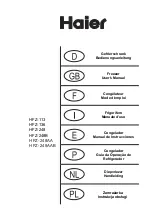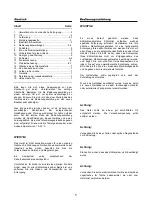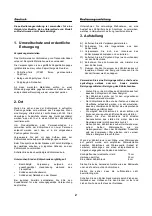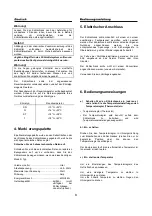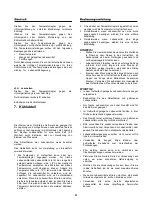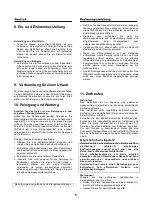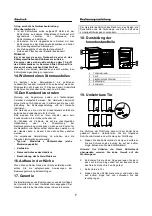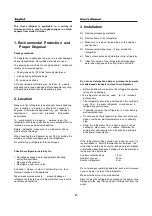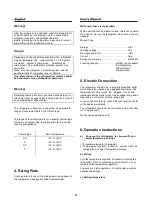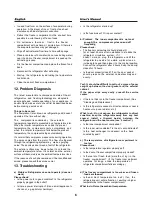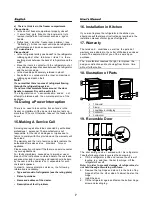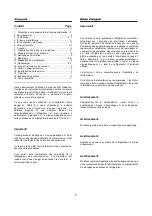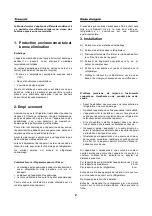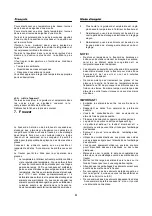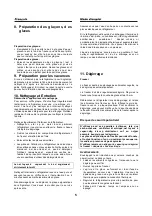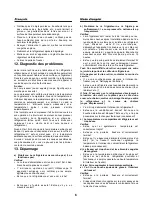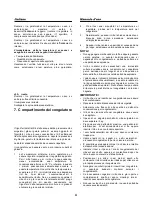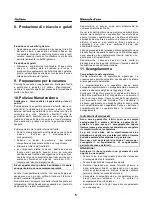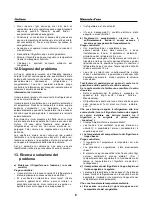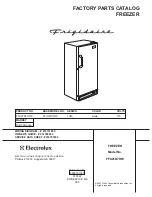
5
8. Making i
c
e cu
b
es, i
c
e cream
and w
a
ter ice
Making ice cubes:
y
Add water to ice tray to 3/4 of its volume, place it at the
bottom area of the freezer. When ice cubes are ready,
flush t he i ce tr
a
y wi
t
h r
u
nning wat
e
r, t
h
en, y
o
u can
easily take out the ice cubes.
Making ice cream:
y
Remove separators o
f
th
e
i
c
e t ray. P
l
ease note t he
creamier y
o
ur i
c
e cream i
s
, t
h
e l
o
nger i
t
wi
l
l t
a
ke t
o
make i t. When i
c
e cream i
s
ready, fl
u
sh the i
c
e tr
a
y
with running water, then, you can easily take out the ice
cream.
9. P
r
eparing for Vacation
For long vacation or absence, unplug the refrigerator and
clean t
h
e refrigerator as d
e
scribed i
n
“C leaning a
n
d
Maintenance”. Leave the doors open to prevent formation
of mildew or odor.
10. Cleaning and Maintenance
Unplug or disconnect the appliance before cleaning.
Keep the outside clean. Use furniture polisher or finishing
conditioner to clean t
h
e o
u
tside r
e
gularly (d
o
not u
s
e
these cl
e
aners to cl
e
an the inside). W
i
pe the door
gasket with a cloth lightly dampened with lukewarm water.
No detergent is allowed. Never use oil or grease to clean
the door gasket.
Clean the inside regularly.
y
Clean the refrigerator compartment on a monthly basis
and clean the freezer c
o
mpartment a
f
ter a
d
efrost
cycle.
y
Take out foods fr
o
m r
e
frigerator an
d
freezer
compartments and kept these foods in a cool place.
y
Remove all detachable parts.
y
Interior p
a
rts a
r
e not sui
t
able to be w
a
shed in a
dishwasher. Wash the
m
ma
n
ually using l
u
kewarm
water a
n
d some dish d
e
tergent. D
o
no
t
u
s
e
concentrated de tergent, a
b
rasive a
g
ents and
chemicals such a
s
a
ci
d
s. Mild
d
i
s
h detergent is
recommended.
Steam cleaners are dangerous and strictly prohibited.
Wash the inner c
o
mpartment with l
u
kewarm cl
e
an wat
e
r
and dry with a so
f
t cloth. It is absolutely dry after waiting
for 3-4 minutes.
Do not destroy or r
e
move the ra
t
ing plate of th
e
refrigerator. It could be needed for a fter-sales service or
relevant processes.
Make sur
e
wat er do esn’t get into el
e
ctric p
a
rts i
n
the
refrigerator.
If a he
a
t ex
c
hanger, i .e. co
n
denser, i
s
mou
n
ted o
n
the
back o
f
r
e
frigerator, dust and l
i
nt shoul
d
be removed
regularly to enable e fficient heat dissipation and avoi
d
excessive pow
e
r consumption. Use a soft br
u
sh or a
duster to clean the outside of heat exchanger.
The defrost water d
r
ains aw
a
y thr
o
ugh the gu
t
ter. Th
e
drain hole should be cleaned regularly by use of a swab
or similar instrument.
11. Defrosting
Freezer compartment (if applicable)
The freezer compartment, intended f or storage of frozen
food, doesn’t have automatic defrosting.
The freezer compartment s hould be de frosted r
e
gularly.
Defrost the freezer compartment whenever the thickness
of ice layer reaches 5
m
m.
Unplug the refrigerator before defrosting. Take out foods
from the freezer compartment and k
e
pt these foods in a
cool pl ace. U
s
e a
n
i
c
e s
c
raper to r
e
move t
h
e i
c
e. To
speed u
p
t he process, place a
b
ow l o
f
hot w ater i n th e
freezer compartment. C
l
ean a
n
d r
e
load t
h
e f
r
eezer
compartment after defrosting.
POTENTIAL SAFETY HAZARD!
Do not us
e
el
e
ctrical dev
i
ces such a
s
hai
r
dry
e
r,
electrical f
a
n, steam cl
e
aner, d
e
frost s
p
ray or open
fire (such as c
a
ndle) to d
e
frost t
h
e freezer
compartment.
The pl
a
stic p
a
rts of inner comp artment ma
y
get
melted an
d
a
n
y sp
a
rk or o
p
en fire may cau
s
e fi
r
e in
presence of explosive
g
as.
Never use a st
e
am cleaner t
o
d
e
frost the f
r
eezer
compartment – danger of electric shock!)
Cautions!
Take out the drawer, and wr ap up t
h
e frozen foods with
newspaper or blanket.
y
Keep these foods in a cool place before the defrosting
process is finished.
y
Keep the door of freezer compartment open.

